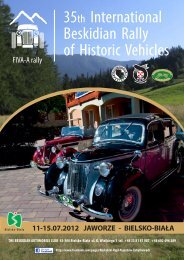FORUM INTERNATIONAL SUR L'AUTHENTICITE DU VEHICULE HISTORIQUE ...
FORUM INTERNATIONAL SUR L'AUTHENTICITE DU VEHICULE HISTORIQUE ...
FORUM INTERNATIONAL SUR L'AUTHENTICITE DU VEHICULE HISTORIQUE ...
Create successful ePaper yourself
Turn your PDF publications into a flip-book with our unique Google optimized e-Paper software.
féminin, en passant par les carrossiers qui ont<br />
réalisé les célèbres sculptures en mouvement.<br />
Pour tous, le symbole c’est Battista Pininfarina qui,<br />
avec la Cisitalia Type 202 de 1948 (qui est joliment<br />
exposée au MOMA de New York ) a donné un coup de<br />
timonier au design de l’automobile et a eu l’intuition<br />
de produire en série les carrosseries jusqu’alors<br />
appelées “hors série”, afin que la belle automobile<br />
puisse être utilisée par une clientèle toujours plus<br />
vaste. Le fait que certaines automobiles soient de<br />
véritables œuvres d’art grâce à la main heureuse de<br />
celui qui les a dessinées et l’époque à laquelle elles<br />
ont été construites crée un problème: celui de<br />
l’utilisation.<br />
Il est juste que ceux qui les possèdent veuillent les<br />
utiliser, après tout, c’est pour cela qu’elles sont<br />
conçues. Mais est-ce juste ? Et je m’interroge sur le<br />
fait que certains joyaux soient exposés aux risques<br />
d’accidents, en plus de l’usure mécanique.<br />
Fatalement, les divers composants devront être<br />
remplacés, à commencer par les pneus, les bougies,<br />
les courroies, etc. Ensuite, il faudra changer les<br />
pistons, les valves, les tambours de freins, sans<br />
compter que si un moteur coule une bielle, il devra<br />
être remplacé en tout ou en partie.<br />
En revanche, un tableau a été réalisé pour rester<br />
accroché au mur et être admiré. Mais si par<br />
l’absurde, nous emmenions en promenade la<br />
Joconde de Léonard de Vinci et si un jour, un coin du<br />
tableau devait se casser, ensuite un autre coin, et<br />
que l’on reconstruisait les morceaux détruits, seraitce<br />
toujours le tableau original ? C’est une question à<br />
laquelle chacun pourra répondre de la façon qu’il<br />
jugera la plus appropriée. Et elle est reliée au thème<br />
de ce forum qui est précisément l’authenticité du<br />
véhicule d’époque.<br />
allora chiamate “fuoriserie” affinché la bella<br />
automobile potesse essere utilizzata da una<br />
clientela sempre più vasta.<br />
Ora il fatto che certe automobili sono vere opere<br />
d’arte grazie alla mano felice di chi le ha disegnate<br />
ed all’epoca in cui sono state costruite crea un<br />
problema: quello dell’utilizzo.<br />
É giusto che chi le possiede le voglia usare, perché in<br />
fondo quello è il loro scopo. Ma è giusto? Qui metto il<br />
punto interrogativo, che certi gioielli vengano<br />
esposti ai rischi degli incidenti oltre che della usura<br />
meccanica. Fatalmente i vari componenti si<br />
dovranno sostituire, a cominciare da gomme,<br />
candele, cinghie eccetera. Ma poi bisognerà<br />
cambiare pistoni, valvole, tamburi freni, senza<br />
contare che se si sbiella un motore si dovrà<br />
cambiarlo tutto o in parte.<br />
Viceversa un quadro è stato fatto per restare appeso<br />
al muro ed essere ammirato da fermo. Ma per<br />
assurdo se portassimo in giro la Gioconda di<br />
Leonardo da Vinci e un giorno si rompesse un<br />
angolo, poi un'altra volta un altro angolo e facessimo<br />
ricostruire i pezzi andati distrutti, sarebbe lo stesso<br />
quadro originale? Questa è una domanda alla quale<br />
ciascuno potrà rispondere nel modo che crede più<br />
giusto. E si collega al tema di questo forum che è<br />
proprio l’autenticità del veicolo storico.<br />
La memoria industriale<br />
Ogni automobile è figlia della sua epoca dal punto di<br />
vista della fabbricazione: questo vuol dire che i<br />
materiali e le lavorazioni impiegati per costruire i<br />
singoli pezzi erano quelli disponibili nel periodo<br />
storico corrispondente.<br />
Per fare un esempio visibile a tutti, il pomello del<br />
cambio fabbricato un tempo in bakelite, oggi si fa di<br />
carbonio. Il discorso vale per tutti pezzi tanto che<br />
had the intuition to mass-produce the bodies that up<br />
until then had been “custom-built” so that the<br />
beautiful car could be used by a vaster clientele.<br />
Now, the fact that some automobiles are real works<br />
of art due to the talented hand of the people who<br />
designed them and the era in which they were built<br />
creates a problem: that of using the vehicle. It is only<br />
right that owners want to use them because that is<br />
basically their purpose.<br />
But is it right? And I add a question mark here, that<br />
some jewels are exposed to the risk of accidents as<br />
well as mechanical wear. Inevitably, the various<br />
parts must be replaced, starting with the tires, spark<br />
plugs, belts, etc. Then you have to change the<br />
pistons, valves, and brake disks, not to mention that<br />
if the engine claps out then you have to replace all or<br />
part of it.<br />
On the other hand, a picture was created to hang on<br />
the wall and be admired while standing still. But if<br />
for some stupid reason we took Leonardo da Vinci’s<br />
Mona Lisa around with us and broke a corner one<br />
day, and then another corner, and we rebuilt the<br />
broken pieces, would it still be the original picture?<br />
This is a question that everyone can answer as they<br />
think best. And this is how we arrive at the theme of<br />
this forum, which is precisely the authenticity of the<br />
historical vehicle.<br />
Industrial commemoration<br />
Every automobile is a product of its time from a<br />
manufacturing standpoint, meaning that the<br />
materials and workmanship used to build each part<br />
were those that were available at that particular<br />
time. A visible example of this is the gear stick knob,<br />
which used to be made of bakelite but is now made of<br />
carbon. The same can be said for all the parts, to the<br />
extent that if we want to tell the story of the<br />
Gianni Rogliatti<br />
61








